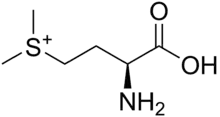S-Methylmethionine
S-Methylmethionine (SMM) is a derivative of methionine with the chemical formula (CH3)2S+CH2CH2CH(NH3+)CO2−. This cation is a naturally-occurring intermediate in many biosynthetic pathways owing to the sulfonium functional group. It is biosynthesized from L-methionine which is first converted to S-adenosylmethionine. The subsequent conversion, involving replacement of the adenosyl group by a methyl group is catalyzed by the enzyme methionine S-methyltransferase. S-methylmethionine is particularly abundant in plants, being more abundant than methionine.[2]
 | |
| Names | |
|---|---|
| IUPAC name
(3-Amino-3-carboxy-propyl)-dimethyl-sulfonium | |
| Other names
S-Methyl-L-methionine Vitamin U | |
| Identifiers | |
CAS Number |
|
3D model (JSmol) |
|
| ChEBI | |
| ChemSpider | |
| KEGG | |
PubChem CID |
|
| UNII | |
InChI
| |
SMILES
| |
| Properties | |
Chemical formula |
C6H14NO2S+ |
| Molar mass | 164.243 g/mol |
| Melting point | 139 °C (282 °F; 412 K)[1] (bromide salt, decomposes) 134 °C (273 °F)[1] (chloride salt, decomposes) |
| Hazards | |
| Lethal dose or concentration (LD, LC): | |
LD50 (median dose) |
2760 mg/kg (iv, mice, chloride salt)[1] |
Except where otherwise noted, data are given for materials in their standard state (at 25 °C [77 °F], 100 kPa).
Infobox references | |
S-Methylmethionine is sometimes referred to as vitamin U,[3] but it is not considered a true vitamin. The term was coined in 1950 by Garnett Cheney for uncharacterized anti-ulcerogenic[4] factors in raw cabbage juice that may help speed healing of peptic ulcers.
Biosynthesis and biochemical function
S-Methylmethionine arises via the methylation of methionine by S-adenosyl methionine (SAM). The coproduct is S-adenosyl homocysteine.[2]
The biological roles of S-methylmethionine are not well understood. Speculated roles include methionine storage, use as a methyl donor, regulation of SAM.[2] A few plants use S-methylmethionine as a precursor to the osmolyte dimethylsulfoniopropionate (DMSP). Intermediates include dimethylsulfoniumpropylamine and dimethylsulfoniumpropionaldehyde.[5]
Beer flavor precursor in barley malt
S-Methylmethionine is found in barley and is further created during the malting process. SMM can be subsequently converted to dimethyl sulfide (DMS) during the malt kilning process, causing an undesirable flavor. Lightly kilned malts such as pilsner or lager malts retain much of their SMM content while higher kilned malt such as pale ale malt has substantially more of the SMM converted to DMS in the malt. Darker kilned malts such as Munich malt have virtually no SMM content since most has been converted to DMS. Other crystal malts and roasted malts have no SMM content and often no DMS content since the kilning also drives that compound out of the malt.[6][7]
References
- Merck Index, 12th ed., 10165 ISBN 0-911910-12-3
- Bourgis F (1999). "S-methylmethionine plays a major role in phloem sulfur transport and is synthesized by a novel type of methyltransferase". The Plant Cell Online. 11 (8): 1485–1498. doi:10.1105/tpc.11.8.1485. PMC 144290. PMID 10449582.
- National Center for Biomedical Ontology. "Methylmethionine Sulfonium Chloride". Archived from the original on 2013-04-14. Retrieved 2013-06-01.
- Cheney G (September 1950). "Anti-peptic ulcer dietary factor (vitamin "U") in the treatment of peptic ulcer". J Am Diet Assoc. 26 (9): 668–72. doi:10.1016/S0002-8223(21)30396-0. PMID 15436263. S2CID 38393819.
- McNeil SD (1999). "Betaines and related osmoprotectants. Targets for metabolic engineering of stress resistance". Plant Physiology. 120 (4): 945–949. doi:10.1104/pp.120.4.945. PMC 1539222. PMID 10444077.
- Pitz, W. Factors affecting S-Methylmethione levels in malt, Journal of American Society of Brewing Chemists, 1987.
- Hornsey IS (1999). Brewing. Royal Society of Chemistry. p. 47. ISBN 9780854045686.
External links
- Vitamin U at the US National Library of Medicine Medical Subject Headings (MeSH)